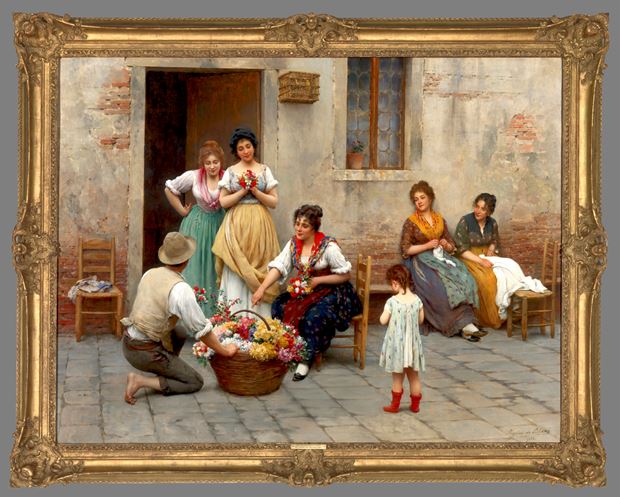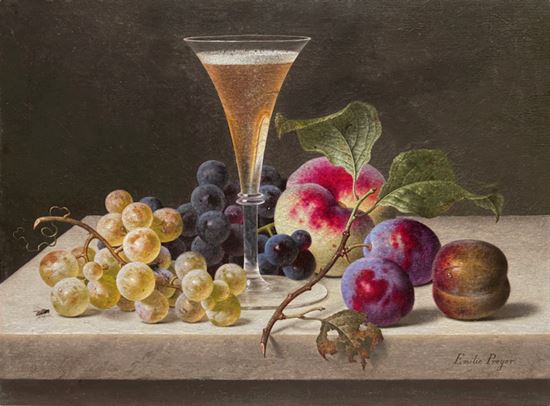Eugene de Blaas
(1843 - 1932)
The Venetian Flower Vendor
Signed and dated, lower right: Eugène de Blaas/1901.
Oil on canvas
39 x 51 in – 99.1 x 129.5 cm
Frame size
46¾ x 59½ in – 119 x 151 cm
Oil on canvas
39 x 51 in – 99.1 x 129.5 cm
Frame size
46¾ x 59½ in – 119 x 151 cm
Height 10⁷/₈ in (119 cm)
width 11¹/₂ in (151 cm)
width 11¹/₂ in (151 cm)
Tel.: +44 (0)20 7839 7693
Provenance
The Yawkey Family Collection;
Acquired by Mr and Mrs Haussner in Atlantic City in 1940;
Sotheby’s, New York, 2 November 1999, lot 88;
Private collection, USA;
MacConnal-Mason Gallery, London, 2010;
Private collection, UK
Acquired by Mr and Mrs Haussner in Atlantic City in 1940;
Sotheby’s, New York, 2 November 1999, lot 88;
Private collection, USA;
MacConnal-Mason Gallery, London, 2010;
Private collection, UK
The present work is exceptional on a number of levels, not least the inclusion of seven figures. De Blaas' mastery of compositional balance is also clearly evident as is his handling of colour; despite the extraordinary vibrancy of the myriad, bold tones there is an overriding sense of harmony throughout. De Blaas' married one of his Venetian models and the fact that the male figure's face in the present work remains hidden, strongly suggests a modest self-portrait.
Biography
Eugene de Blaas was born to Austrian parents. His father, Karl (1815-1894), teacher to him and his brother Julius (b.1845) became Professor at the Academy in Vienna and Venice, then part of the Austro-Hungarian Empire.
It was in Venice that Eugene de Blaas established himself as the leading painter of Venetian genre. The golden Italian climate and the magnificent old stone facades had made Venice an essential stop on the Grand Tour since the early eighteenth century. Past visitors had returned home with views and portraits; the late nineteenth visitor wanted more. The affluent Venetian visitor wanted human interest, a sense of life by the canals and campos of the city, as a result of which, a school of artists developed to supply this market.
Native Italian artists including Antonio Ermolao Paolettii (1834-1912) and Antonio Rotta (1828-1903), Sir Samuel Luke Fildes, RA (1843-1927) and William Logsdail (1859-19444) from England, but above all Eugene de Blaas, depicted the life of fisherfolk, gondoliers and most notably the famed Venetian beauties. These smiling, conversing, flirtatious ladies are often displayed against the pale, impressionistic, stonework of the city walls. One particular beauty, Paola Prina, married de Blaas in 1870 and is often depicted is his works. The titles of his paintings “The Love Letter”, “Stolen Kiss”, “The Suitor”, with his highly polished technique, the depiction of embroidered lace, auburn hair and a coquettish glance, ensured that his paintings were of universal appeal.
Between 1875 and 1891 de Blaas exhibited twelve works at the Royal Academy, London. By 1885 he was represented by the art dealer Arthur Tooth & Son in London before moving to his rival T. Maclean from 1886, also in London, an indication of the artist’s enduring popularity in Britain.
His works can be found in museums in: Bournemouth; Leicester; Nottingham; Sheffield; Vienna; Melbourne and Sydney, Art Gallery of New South Wales.
It was in Venice that Eugene de Blaas established himself as the leading painter of Venetian genre. The golden Italian climate and the magnificent old stone facades had made Venice an essential stop on the Grand Tour since the early eighteenth century. Past visitors had returned home with views and portraits; the late nineteenth visitor wanted more. The affluent Venetian visitor wanted human interest, a sense of life by the canals and campos of the city, as a result of which, a school of artists developed to supply this market.
Native Italian artists including Antonio Ermolao Paolettii (1834-1912) and Antonio Rotta (1828-1903), Sir Samuel Luke Fildes, RA (1843-1927) and William Logsdail (1859-19444) from England, but above all Eugene de Blaas, depicted the life of fisherfolk, gondoliers and most notably the famed Venetian beauties. These smiling, conversing, flirtatious ladies are often displayed against the pale, impressionistic, stonework of the city walls. One particular beauty, Paola Prina, married de Blaas in 1870 and is often depicted is his works. The titles of his paintings “The Love Letter”, “Stolen Kiss”, “The Suitor”, with his highly polished technique, the depiction of embroidered lace, auburn hair and a coquettish glance, ensured that his paintings were of universal appeal.
Between 1875 and 1891 de Blaas exhibited twelve works at the Royal Academy, London. By 1885 he was represented by the art dealer Arthur Tooth & Son in London before moving to his rival T. Maclean from 1886, also in London, an indication of the artist’s enduring popularity in Britain.
His works can be found in museums in: Bournemouth; Leicester; Nottingham; Sheffield; Vienna; Melbourne and Sydney, Art Gallery of New South Wales.




